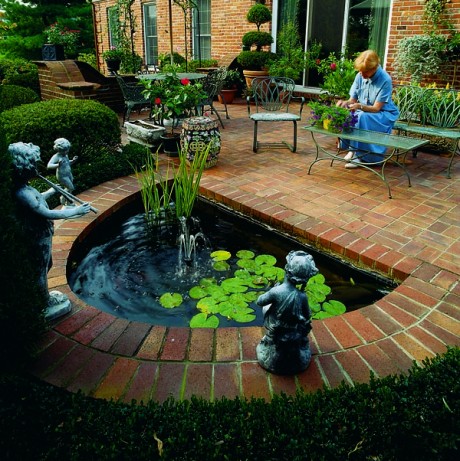Water, Water Everywhere
How water features can enhance your landscape
By Katie Lamar JacksonThere's nothing like a water feature to enhance landscapes and homes. Water features are not only beautiful, they can add value to property.
Using them wisely, however, is important. If you are thinking of adding water elements to your world, plan them well and find ways to use the water as efficiently as possible.
Options range from large ponds and flowing streams to pools, fountains and bird baths. To find the right feature for your needs, determine what purpose you hope it will serve. For example, if you simply want the serene sound of trickling water, that can be as easy as using an indoor fountain in a room or office.
If, on the other hand, you want to draw wildlife, enhance an ecosystem or add an impressive focal point to your landscape, then pools, ponds and waterfalls may be your best bets. In this case, you may want to enlist the help of a professional landscape designer.
Know your water resources. If you live in an area with wetlands, a stream or boggy spots, a water feature can turn those natural sources of moisture into something beautiful and beneficial. Sometimes it can even solve runoff and excess water problems around your home and property.
If, in contrast, your site tends to be hot and arid, water can help cool your home or patio and provide much-needed habitat for insects and animals. However, in this case, water can be an expensive option and you'll want to look for ways to use alternative sources of nonpotable water.
And if you live in an urban environment with lots of concrete and hardscape, features such as fountains and water-filled containers not only can beautify your space but help diminish noise pollution as well.
There are several ways to have an economical and environmentally sound water feature. One option is to use rain barrels and cisterns. They collect water from rooftops, which can then be used to irrigate garden areas or feed into fountains and other features. In fact, rain barrels are now available that combine water collection with a water feature, such as a fountain function. You can also collect condensation from air conditioning units and feed this water into water features.
Rain gardens are another option. These are actually garden areas developed to collect and filter pollutants from water that runs off driveways, lawns and other ground surfaces.
If you already have a swimming or reflecting pool, water from either can be recirculated through fountains and waterfalls.
Powering your water feature
But how about powering these water projects? Tranquil water features require no electricity to operate. Aside from making sure the water does not become a breeding ground for mosquitoes, still water can be relatively easy and inexpensive to incorporate. For example, pots filled with water, water plants and fish can be used on porches. Another efficient option used for waterfalls and water gardens is to use natural gravity to move water, such as placing a water feature on a slope so rainwater or streams move along on their own. And another way to save on electricity is to use solar-powered pumps.
Restrictions and safety
Make sure you contact your local municipal authorities to ensure that you are complying with any water and land-use restrictions. Finally, keep in mind that a water feature, no matter how small and shallow, can be a danger to small children and pets. Be sure to secure it as well as possible.
About the Author
Katie Lamar Jackson is chief editor at the Auburn University College of Agriculture and the Alabama Agricultural Experiment Station.-
Share this story:
{ampz:Custom share for module}
